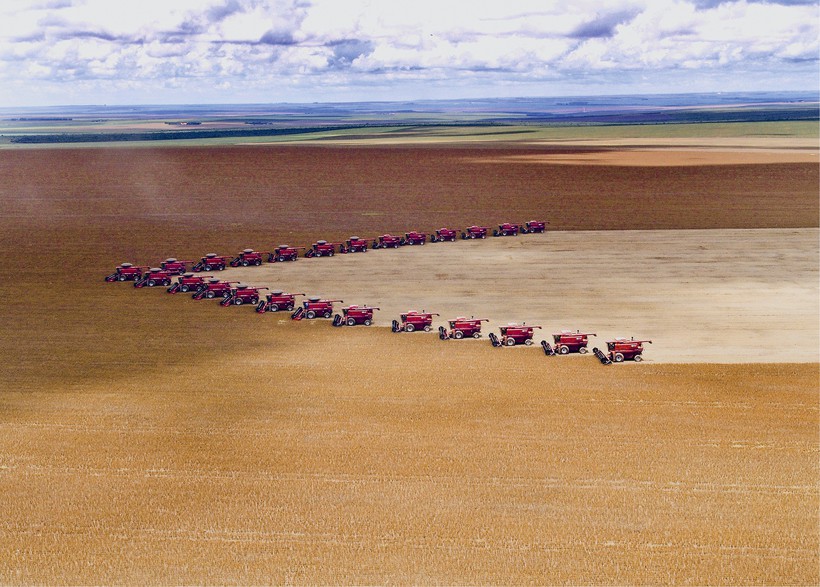Can BRICS Feed the World?
Maria Printseva
2015 will see a review of the UN Millennium Development Goals. The first was to reduce the prevalence of hunger in developing countries by half. The latest data published by the UN Food and Agriculture Organization (FAO) showed that hunger has gone down significantly around the world – 18.7% of the world’s population were suffering from chronic hunger between 1990 and 1992, but that figure dropped to 11.3% between 2012 and 2014. In developing countries, this indicator has gone down from 23.4% to 13.5% in the same period. However, despite nearly meeting the target, the food issue has still not been fully resolved.
Two key requirements should be implemented to fully meet the UN’s objective and eradicate hunger: 1) produce enough food and 2) distribute it rationally. While today’s food production is nominally enough to feed the entire planet, the heart of the problem lies in inefficient supply chains, and the situation may change drastically in the future.
Growing populations, the increasing role of the middle class, changes in the nature of consumption, and catastrophic depletion of natural resources that support agricultural production may bring about a significant hike in food shortages. According to FAO, global food production will need to be increased by 70% – and by as much as 100% in the developing world alone – to eradicate hunger and fully meet food demand by 2050. This objective seems difficult today, not least because of the growing risk of natural resource shortages. The approaches that have ensured greater production and higher productivity levels for the last several decades have inflicted irreparable environmental damage; caused land degradation; polluted soil, water, and air; and reduced biodiversity. According to the World Wide Fund for Nature (WWF), we use 50% more natural resources than the planet can generate every year. If the current model persists, we will need to double the level of natural resources currently available by as early as 2030. This means that the global community is running the risk of not only failing to reduce the proportion of the population suffering from hunger during the next development stage, but even that of getting back to where we started.
In every case, this explosive growth – in the sector in general and in selected regions in particular – was predicated on an expanded toolbox of technologies and solutions that could be used to produce, store, and distribute food products. It should be noted that technological innovations implemented in the agricultural sector had to do primarily with development, subsequent scalability, and greater affordability of technologies in other sectors that were often irrelevant to agriculture
In the past, tackling food issues only required a nominal amount of natural resources. But going forward, resource limitations will become a decisive factor. Are there any solutions that can take into account such limited resources, and what can be done to implement them?
Stages of Agricultural Development
Let us look at several potential solutions that may help to increase productivity and ensure proper food distribution against the backdrop of a global deficit of natural resources by narrowing the field down to one of the key agricultural segments: crop farming.
Throughout the 20th century and in the early 21st century, the history of agricultural development saw a number of success stories where productivity in crop farming grew exponentially on the scale of entire economies, especially in developing markets. In every case, this explosive growth – in the sector in general and in selected regions in particular – was predicated on an expanded toolbox of technologies and solutions that could be used to produce, store, and distribute food products. It should be noted that technological innovations implemented in the agricultural sector had to do primarily with development, subsequent scalability, and greater affordability of technologies in other sectors that were often irrelevant to agriculture. For instance, during the initial stages of agricultural development, food production was largely based on manual labor and required simple tools and organic fertilizers, while production growth was mainly driven by the so-called ‘extensive method’ (that involved expanding farmed territories). Transportation of food products was limited to neighboring communities and the market was local in nature. By and large, this approach remained the same until pro-active industrialization swept the world in the 1930s and 1940s.
During the second development stage, producers adopted new agricultural equipment (thanks to advances in mechanical engineering), upgraded organic fertilizers to chemical fertilizers, and improved plant resistance through plant breeding innovations. All of the above heralded a transition to intensive farming methods that made it possible to increase productivity without expanding farmed territories. A number of drastic steps implemented in the agricultural sector by developing countries enabled them to exponentially increase productivity, paving the way for the so-called ‘Green Revolution.’ Between 1960 and 2000, average crop yield per hectare in the developing world went up by 208% for wheat, 109% for rice, 157% for corn, and 78% for potatoes. During the same period, new methods of processing (pasteurization) and storing (freezing) were introduced. Transport and infrastructure also received a boost, which helped to augment hauling capacities and to expand to international markets, strengthening the role of the state and large manufacturers in the process of product distribution.
Starting from the end of the last century, the more progressive farmers in developed countries were given new opportunities to increase their productivity and reduce negative environmental impact, as well as to save natural resources based on the logic of a resource efficient model. For instance, farmers were able to manage their businesses virtually without leaving home. Sowing crops, fertilization, irrigation, monitoring, and harvesting were done according to specific requirements using robotic equipment, satellite positioning, and the Internet. This method, which came to be known as ‘precision farming’ has a proven track record in the developed world. Information technologies that have become part and parcel of modern agricultural methods also made it possible to build more efficient logistical chains, which has made the agricultural products market truly global and promoted the role of businesses (like the global corporations responsible for the lion’s share of world production and distribution of finished products) via global supply chains.
According to FAO, global food production will need to be increased by 70% – and by as much as 100% in the developing world alone – to eradicate hunger and fully meet food demand by 2050. This objective seems difficult today, not least because of the growing risk of natural resource shortages. The approaches that have ensured greater production and higher productivity levels for the last several decades have inflicted irreparable environmental damage, caused land degradation, and polluted soil, water, and air
Thus, the technological solutions that make production and re-distribution of agricultural products more efficient have become affordable and are widely used in practice. They also help to reduce the negative environmental effects – something that is also in line with the current, topical requirement to account for the shortage of natural resources in food production. However, is this really enough to solve the problem?
The first limitation which these methods and technological solutions impose is the stringent manufacturer qualification criteria. They are virtually unattainable for some farmers in developing countries, the majority of whom represent the poorest and least literate of the population. Second, because of their low-income levels, many farmers often cannot afford to use chemical fertilizers and advanced equipment – even with the obvious advantages they offer. To do this, they would require financial support and lending mechanisms that are not always in place. Third, making these new technologies truly scalable would require a better infrastructure and regulatory framework. All of these factors pose significant institutional, regulatory, and infrastructural challenges. Whether these can be overcome in the developing countries remains an unanswered question.
The BRICS countries have traditionally been viewed as leaders among other developing markets. Their experience presents a valuable lesson that needs to be studied while best practices and lessons learned need to be implemented across the board.
Natalia Zaitseva is head of the Sustainability Lab at the Institute for Emerging Market Studies SKOLKOVO.Anastasia Belostotskaya is analyst at the Sustainability Lab at the Institute for Emerging Market Studies SKOLKOVO.
Maria Printseva is junior analyst at the Sustainability Lab at the Institute for Emerging Market Studies SKOLKOVO.
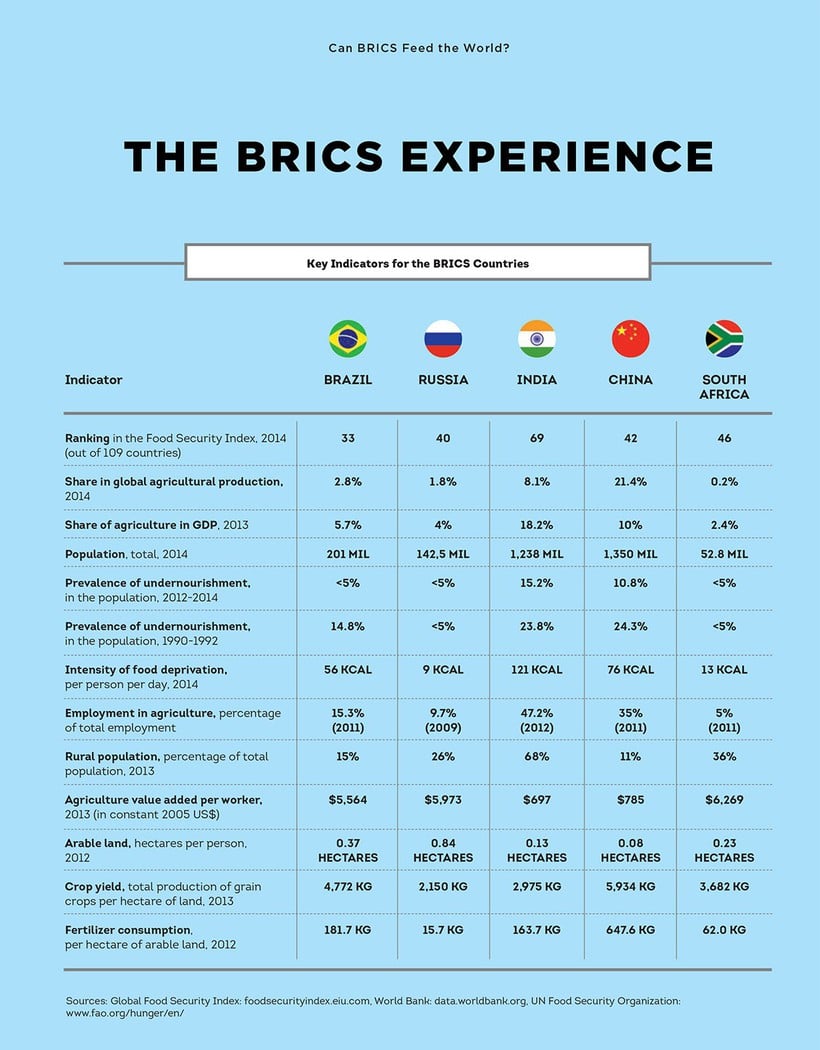
Brazil
In the last 30 years, Brazil has moved from the 16th to the 5th position in global agricultural production volume, and turned from an importer to one of the largest exporting countries in the global market. The prevalence of undernourishment in the country has gone down from 15% in 1990-1992 to less than 5% in 2012-2014, which is in line with similar indicators in developed countries. These significant strides were possible thanks to the development of the country’s agricultural sector and Brazil’s integration into international markets, which were initially considered as a channel for commercialization of production surplus, but ultimately proved to be a successful growth strategy.
The primary objective of the agricultural development process in Brazil was to ensure food security for the population and create incentives for the country’s economic growth. Brazil’s efforts to scale up production and transition from extensive and intensive farming methods to a more resource efficient and sustainable model formed the basis of the country’s agricultural reforms.
In the initial stages, it was proposed that production should be scaled up through extensive development of agricultural lands. However, the expansion to regions in Brazil such as the cerrado (savanna) and Amazon rainforests did not yield the desired results. The soil in the savannas was barely fertile and could not be used for traditional farming, while large-scale logging in the Amazon forests caused significant damage to the environment and, though it was not obvious at the time, contributed not only to climate change in the region but also resulted in sluggish agricultural productivity. These restrictions were the main reason why the country embarked upon revamping its approaches to agriculture and started looking for new technological solutions that would not only increase productivity but also minimize negative effects.
In the last 30 years, Brazil has moved from the 16th to the 5th position in global agricultural production volume, and turned from an importer to one of the largest exporting countries in the global market. The prevalence of undernourishment in the country has gone down from 15% in 1990-1992 to less than 5% in 2012-2014, which is in line with similar indicators in developed countries. These significant strides were possible thanks to the development of the country’s agricultural sector and Brazil’s integration into international markets
The Brazilian National Agricultural Research Corporation (Embrapa) played a special role in implementing new technological solutions. Incidentally, Embrapa has become the driving force behind the development of the country’s agricultural sector. One of its tasks was to conduct a study that looked into implementing new technologies, analyzing their economic effects, developing programs to foster their scalability, and promoting resource efficient farming methods among producers. The cerrado region is a particularly telling example of Embrapa’s efforts – despite the fact that it was initially declared unfit for farming, today it accounts for more than 45% of the country’s total grain output.
The ABC Foundation also made a significant contribution to promoting resource efficient technologies. The Foundation initially worked with pilot sites and later went on to disseminate proven methodologies among farmers.
Concurrently with the introduction of these new technological solutions, agricultural lending programs were launched to help develop infrastructure and integrate family farms into agricultural production chains. The government launched a policy of minimum prices, which enabled it to ensure a sustainable level of income for farmers and maintain balanced food security.
Strong institutional support from national organizations, along with the development of a research framework and infrastructure, financial support for farmers, market liberalization, and comprehensive media coverage of these issues created an environment conducive to the introduction of new technologies. Production growth not only made it possible for the country to meet its domestic demand for food, but also to play a competitive role on the global market.
Russia
Russia is ranked 40th in the Food Security Index and boasts great agricultural potential thanks to its vast resources. Russia is a global leader in a number of areas. For instance, the country has 9% of the planet’s arable lands, 50% of its black soil, one of the largest freshwater reserves in the world, and 25% of global forests. The dynamic development of its agricultural sector during the Soviet period enabled the country to resolve some of its most vital food security issues, bringing it level with other developed nations – the prevalence of undernourishment was just under 5% by 1991. During the Soviet era, significant inroads were made in terms of infrastructure, agricultural equipment, and competency development – something that companies operating in this sector depended on until recently. During the last decade, Russia’s agricultural sector showed overall upward growth unlike many other industrial sectors. In 2013 the country’s production growth index reached 5.8%. Preliminary data in 2014 put it at 3.7%, and experts predict further growth in 2015.
Despite the availability of natural resources and the advanced development of the sector as a whole, agriculture in Russia still faces its own problems. Soil erosion in some regions has reached an estimated 50% to 60%, prompting experts to coin the term, ‘dead black soil,’ showing how the crisis has affected even the most fertile lands. The fact that the country has traditionally relied on its legacy strengths reduces its motivation to invest in agricultural development, which gradually makes its industrial equipment obsolete; today the rate of wear and tear affecting agricultural equipment has reached 70%. The sector is also struggling with low salaries and a rapidly aging workforce, with the average age reaching 45 to 50. In light of that, Russia may soon be faced with serious sustainable growth challenges on a similar scale to other BRICS countries, which have for many years relied predominantly on the intensive farming model.
The implementation of resource efficient technologies in Russia is fragmented at best, and government policy and support mechanisms are in the early stages of development. At the same time, development programs adopted by some of the most progressive holdings provide for more sustainable farming methods, which means that the chances of moving on to new models for small and medium farms, as well as incentives to do so, are quite limited. They have limited access to investment capital and government support mechanisms, and they are also struggling to ensure stable product sales due to considerable barriers in federal retail chains because the market is saturated with competing products from abroad. When it comes to potential capabilities of such resource efficient technologies, the level of awareness remains rather low and is mostly predicated on contributions from private interest groups and industry associations. For example, the National Movement for Resource Saving Crop Production publishes Russia’s only magazine dealing with state-of-the-art technologies and overseas practices, as well as provides assistance in establishing demonstrative farms to validate innovation methodologies in agriculture and to support education.
Much like in several other BRICS countries, global companies operating on the domestic market act as a powerful factor driving the transition to a more sustainable model no matter how rigorous (or weak) the government policy. For instance, Unilever operates in the global marketplace in compliance with sustainable development principles and demands similar compliance from its local suppliers. One of the company’s objectives set out in the 2020 Unilever Sustainable Living Plan is to reach sourcing of 100% of agricultural raw materials based on environmentally sound (sustainable) methods to be further used to meet its own production needs. By as early as 2015, the company plans to purchase 100% of its sunflower oil on a sustainable basis to feed its local production. Monomakh CJSC, a Russian supplier of sunflower oil, relies on Unilever’s methodological support to gradually rebuild and certify its farms in the Krasnodar region and Rostov oblast – based on criteria including ‘agrochemicals and fuel,’ ‘advanced work methods,’ and ‘compliance with legislation.’
Despite a number of success stories, global companies in Russia often have to go abroad to source feedstock for Russian domestic production facilities because Russian businesses fail to meet requirements and are not ready to transform their business models. The situation may begin to improve as Russian suppliers change their attitudes on business sustainability requirements.
China
According to the International Monetary Fund, China’s economy became the largest in the world in terms of PPP (purchasing power parity) in 2014. China accounts for 21.4% of global agricultural production, which places the country at the very top globally. At the same time, virtually all of its output is consumed domestically. Despite these impressive indicators, prevalence of undernourishment remains rather high (at 11.4%) compared to the rest of the BRICS countries, except India, where undernourishment is even higher. The rising demand for food is predicated on population changes and a growing middle class that tends to consume more per capita. By 2020, the middle class will account for more than 40% of the population (compared to 10% today).
China’s efforts to confront its growing food security problems are impeded by the devastating consequences of the large-scale intensive farming that has been practiced for decades. China’s current agricultural system was shaped in 1980; it drove the country’s economic growth and simultaneously imposed limitations on further development. What made the new system stand out was the household-based approach, whereby the efficiency of every household depended on production results directly. In an effort to achieve greater efficiency, farmers relied on intensive agriculture methods. As a result, a number of experts estimate China’s losses of agricultural lands at 37% of the nation’s entire territory. Soil degradation, drought, desertification, and expanding disaster-prone areas (since 1990, the country has averaged annual losses of nearly 1.5% of its GDP as a result of floods and 1% as a result of droughts) pose a serious threat both to the agricultural sector and the long-term development of the Chinese economy as a whole. In the last couple of years alone, desertification has continued to affect several thousand communities, while swift urbanization prevents further expansion of agricultural lands. The availability of arable lands per capita in China is two to four times lower than that of the other BRICS countries.
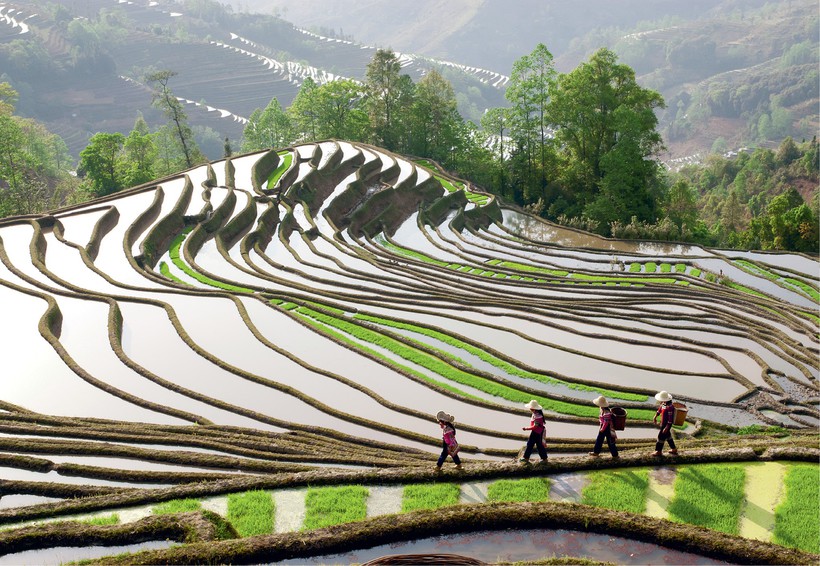
China’s current agricultural system was shaped in 1980; it drove the country’s economic growth and simultaneously imposed limitations on further development. What made the new system stand out was the household-based approach, whereby the efficiency of every household depended on production results directly. In an effort to achieve greater efficiency, farmers relied on intensive agriculture methods. As a result, a number of experts estimate China’s losses of agricultural lands at 37% of the nation’s entire territory. Soil degradation, drought, and expanding disaster-prone areas pose a serious threat both to the agricultural sector and the Chinese economy as a whole
Environmental issues are among China’s most painful pressure points slowing the development of its agricultural sector. The transition to a sustainable agricultural model has been on the agenda in China for a long time. The term ‘ecological agriculture’ (shengtai nongye) first came into use in China in 1980 when the country’s government organized the first nation-wide conference on agricultural economy in Yinchuan. Today the Chinese government provides target financing to stimulate research about resource efficient methods and the implementation of innovative technologies. In 2014, for example, over $100 million was invested into more than 2,500 projects designed to improve the quality of fertilizers.
In order to address the problems faced by the agricultural sector, the Chinese government is also striving to foster international cooperation with other countries that have a proven track record in operating resource efficient technologies. For instance, thanks to the cooperation between China’s Ministry of Agriculture, the German Ministry of Food and Agriculture, and a number of German agricultural equipment manufacturers, a Joint German-Chinese Demonstration Farm project was launched in Ganhe. The project took six years and was implemented in December 2014. This work covered 1,000 hectares of land and relied on state-of-the-art agricultural technologies adapted for crop farming and farm management based on the most efficient methods. The results confirmed that natural resources can be conserved and economic costs can be cut while maintaining high productivity.
A whole range of different projects are supported by Cargill, one of the leading global suppliers of food products and agricultural, financial, and industrial goods. To address low qualifications among farmers, Cargill has been conducting regular training programs showcasing cutting-edge technologies that can increase productivity and make farming more profitable. To date, more than 3 million farmers have gone through such training programs. Starting in 2009, Cargill joined forces with the country’s Ministry of Agriculture to help more than 5,000 Chinese farmers improve their irrigation systems and implement other technological solutions to conserve water resources. As a result of many years of work, water consumption has been cut by 20-40%, which has also had a positive effect on the income of farmers. One of the latest initiatives designed to improve grain production in China is being implemented jointly with WWF, Coca-Cola Company, regional authorities, and small farms. This will increase grain production, reduce waste, conserve water resources, and optimize fertilizer usage.
India
More than 60 years ago, Mahatma Ghandi said, “Agriculture is the foundation of the Indian economy.” This still holds true today. India’s agro-industrial sector accounts for 20% of the country’s total national export and provides jobs for nearly 50% of the working population, while 70% of Indian families depend on agriculture for their income. The combination of these factors makes agricultural development one of the basic preconditions for the country’s long-term economic growth.
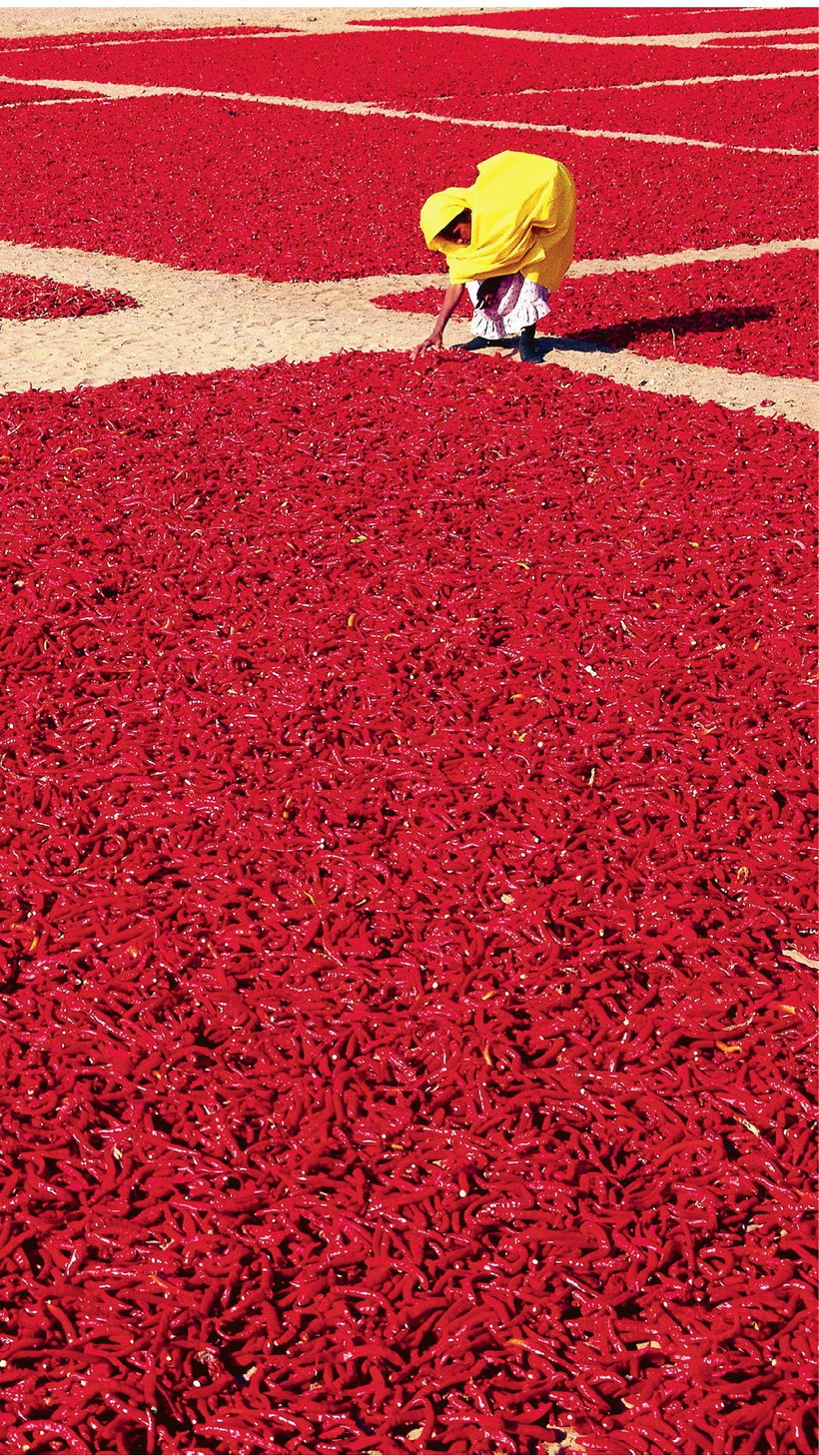 Despite the important role of the intensive model in the development of India’s agriculture in the 1970s and 1980s, growth has gone down in the period from 1990 to 2000, bringing to the fore problems like the availability of technologies, insufficient qualifications of farmers, and low farm revenues. Compared to the other BRICS countries, food security issues are particularly pressing in India. The country never managed to cut its undernourishment rate in half, though it did go down from 23.8% in 1990 to 15.2% today. Labor productivity in India’s agricultural sector is 8 to 10 times lower than in Brazil, Russia, and South Africa. If the population growth rate persists, this will exacerbate other problems, increase the demand for land resources, and place greater emphasis on the further development of intensive farming methods (increased use of fertilizers, development of irrigation systems, etc.), which may yield quick results.
Despite the important role of the intensive model in the development of India’s agriculture in the 1970s and 1980s, growth has gone down in the period from 1990 to 2000, bringing to the fore problems like the availability of technologies, insufficient qualifications of farmers, and low farm revenues. Compared to the other BRICS countries, food security issues are particularly pressing in India. The country never managed to cut its undernourishment rate in half, though it did go down from 23.8% in 1990 to 15.2% today. Labor productivity in India’s agricultural sector is 8 to 10 times lower than in Brazil, Russia, and South Africa. If the population growth rate persists, this will exacerbate other problems, increase the demand for land resources, and place greater emphasis on the further development of intensive farming methods (increased use of fertilizers, development of irrigation systems, etc.), which may yield quick results.
Considering the fact that India is the world’s second largest agricultural producer, trailing only behind China, further intensification may lead to negative consequences. Some of them are already beginning to surface today – depletion of previously fertile soils, a lack of water resources, and irrigation system development has increased the level of ground water (forming marshes) and increased salt content in the soil. However, as opposed to institutional problems, those of an environmental nature have not yet impeded India’s agricultural development.
Just like China in earlier stages, India is characterized by fragmented agricultural areas – 80% of them do not exceed two hectares in size. According to Indian law, after the death of a landowner, his land is inherited by his sons in equal shares. As a result, farming conditions get worse with every new generation, while competition for land resources gives rise to social tension. In the 1990s the government attempted to consolidate farms, but their efforts fell short and only yielded limited results in a few regions (Punjab, Haryana, and the western part of Uttar Pradesh). Today, greater emphasis is placed on creating cooperative farms.
The second factor slowing agricultural development is poorly developed food processing, storage, and sales infrastructure. The issues range from a lack of refrigeration equipment to poor road conditions in rural areas. In addition, product sales are strictly regulated by regional authorities, who may go as far as imposing restrictions on the movement of agricultural goods between districts. Indian farmers depend on intermediaries who use the situation to their advantage and lower the purchasing price. Transactions that involve purchasing or selling selected grain products and oil cultures on the local market (i.e., at the level of villages) may account for 80% to 90% of production volume. The resulting supply chains bring significant profits to the wealthiest part of Indian society; without factoring in specific local requirements, even global corporations may fail, despite their financial prowess and support from the Indian government. This was what happened to Metro Cash & Carry, an international wholesaler, when they first tried to open stores in Bangalore. Direct fruit and vegetable shipments were blocked at the local level, and they were forced to shut down their stores.
Today, a range of measures are being implemented at the state level to foster India’s agriculture, including the development of warehouses and irrigation systems, reducing pricing volatility on the domestic market, providing financing to farmers to acquire new technologies, and promoting lending. India is also betting heavily on attracting foreign investments and fostering international cooperation. To this end, the country signed international cooperation agreements with 63 countries to develop infrastructure, implement modern technologies, and adopt best practices. These broad measures should make the sector more attractive for investors and promote foreign investments, which at some point in the past proved to be one of the main factors driving the growth of the Brazilian agricultural sector. Today, India’s pool of agricultural investors includes ADAMA, an Israeli corporation and the seventh largest fertilizer manufacturer in the world, Syngenta, a Swiss company and one of the global leaders in plant protection and seed care, as well as the aforementioned Metro Cash & Carry network, which at the end of the day managed to overhaul its approach and launch as many as 16 stores across India. This concentration of global players not only enables the country to boost its growth but also creates an environment conductive to a gradual integration of more sustainable farming methods in India.
South Africa
South Africa is the most developed country on the continent. While it is home to a mere 5% of Africa’s population, the country’s share in the region’s aggregate GDP is nearly 30%. One of the factors driving its economic growth is the large-scale reform of the country’s agricultural sector. South Africa is fully capable of meeting its domestic demand for food; the prevalence of undernourishment is estimated at 5%, a level enjoyed by developed economies. South Africa is also one of the leading countries exporting high-value food crops; today it exports more than 140 different types of fruit.Even though South Africa has no difficulties meeting its food demand, its population continues to grow and is forecasted to reach 80 million by 2035, which means that food security may become an acute issue. At the same time, rising unemployment (which reached 25% in 2014, up from 9% in 1980) and a low level of employment in the agricultural sector among the rural population (36% of South Africa’s population vs. 5% of the working population) give rise to another challenge for South Africa – the need to create jobs in the agricultural sector by making it more attractive for small farms. These problems are exacerbated by the country’s climate and by the consequences of the agricultural reforms during the previous development stage.
The country’s agricultural sector has always been evolving in an unfavorable environment. According to a WWF study, South Africa is faced with the greatest shortage of fresh water, which is aggravated by low precipitation levels. Out of 12% of the area showing the greatest promise for agricultural purposes, only 22% is arable land with high potential. Considering the region’s unusual climate and resource limitations, South Africa needs to transition to resource efficient technologies, which will become an important factor in ensuring high enough levels of production in the future.
The agricultural sector’s institutional structure, which was formed as a result of South Africa’s integration into the global marketplace, also imposes limitations. Large-scale investments into new irrigation systems and the removal of trade barriers enabled large farms to gain significant advantages over smaller farms, and shifted their focus from producing the basic products used domestically (such as grain and bean cultures) to more expensive ones slated for export. These changes precipitated export growth from 5% in 1988 to 51% in 2008. At the same time, low-value basic food crops were imported from abroad to meet South Africa’s domestic demand and import tariffs were kept low. This put a great deal of pressure on small-scale farmers, who had to resort to aggressive farming methods to boost production and compete with overseas suppliers. Their excessive use of fertilizers against a backdrop of water shortages had negative environmental effects and virtually closed the door for small South African producers to integrate their businesses into the supply chains of larger producers. This consequently denied them access to the foreign market as they were unable to keep up with production processes and comply with quality requirements. Where market liberalization helped Brazil’s agricultural development, it destroyed South Africa’s institutional structure and caused the number of small farms to drop considerably.
Today, the country’s 2030 Development Plan places a greater emphasis on supporting small-scale farmers and integrating them into existing commercial value added chains. Meanwhile, the growing role of small-scale farms should also be based on modern sustainable technologies, both to boost their export potential and account for their limited resources. Initiatives that are already underway in this area enjoy a great deal of support from WWF and other non-profit organizations, as well as large manufacturers.
One of these initiatives, Living Farm Reference, deserves special mention. It is a master document created by WWF in partnership with GreenChoice, a local non-profit organization. Its primary objective is to increase the awareness of farmers on the basic sustainability principles and practices associated with sustainable agriculture and to incentivize producers and other market agents to transition to sustainable development models.
Another example of such support provided by the private and non-profit sectors is the WWF Sustainable Agriculture Program, launched in partnership with South Africa’s largest bank, Nedbank. The program prioritizes the need to help the agricultural sector adopt sustainable development models to ensure food security in the face of limited resources. Similar programs supported by WWF are being implemented by local companies, such as the Sustainable Sugar Farm Management System, the WWF-Biodiversity and Wine Initiative, and Better Barley Better Beer – where WWF joined efforts with SAB Miller, the world largest brewery company.
***
Even though the BRICS countries do not speak for the entire developing world, they are among the drivers of global economic development. All of them are charged with the task of providing for 40% of the planet’s population in the face of resource shortages. At the same time, all five countries are completely different from one another in terms of their baseline conditions and the problems they face. Yet analyzing their experiences enables us to identify a set of common approaches to removing institutional, regulatory, and infrastructural restrictions, and take into consideration their limited resources.
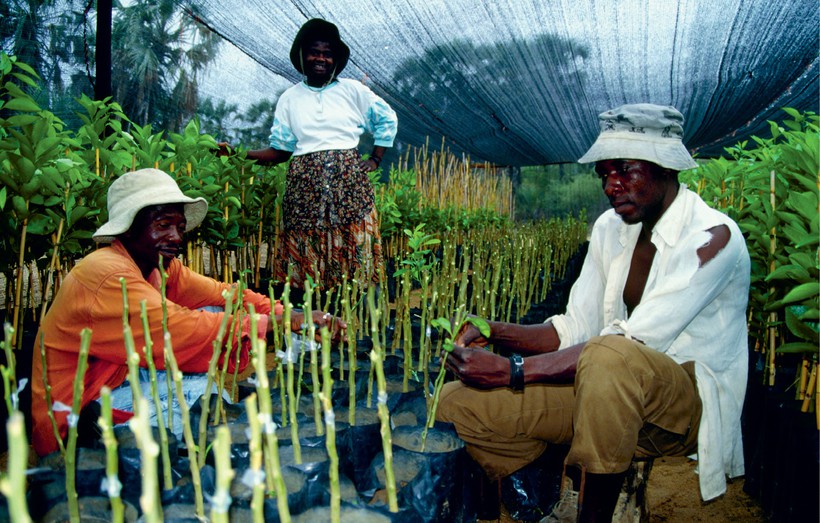
Even though South Africa has no difficulties meeting its food demand, its population continues to grow and is forecasted to reach 80 million by 2035, which means that food security may become an acute issue. At the same time, rising unemployment and a low level of employment in the agricultural sector among the rural population (36% of South Africa’s population vs. 5% of the working population) give rise to another challenge for South Africa – the need to create jobs in the agricultural sector by making it more attractive for small farms
All of these countries have already been forced to deal with the negative consequences of intensive farming methods, albeit to varying degrees. Most of them recognized the need to transition to a resource efficient model. Therefore, what lessons can we learn from the BRICS experience?
When new technologies are implemented, the key to success lies in a holistic approach that involves state-level support and cooperation between key players, including local and international non-profit organizations, local companies and global corporations, manufacturers of food products and suppliers of equipment, seeds, and fertilizers, as well as international and local financial organizations.
These efforts should go hand in hand with a whole host of other measures, such as stepping up research and creating pilot sites at the national level, promoting comprehensive media coverage of these issues, providing training opportunities for farmers, and developing agricultural lending mechanisms.
One of the key steps in the development of the agricultural sector is to ensure a guaranteed level of income for small-scale farmers – for example, by way of introducing minimum prices for their products. Meanwhile, not all government incentives to raise the level of income in agriculture have been successful – in most cases the opposite is true.
This analysis of the BRICS experience in tackling food security issues shows that potential solutions can be found, but they will require an unprecedented consolidation of efforts from all of the major stakeholders.



